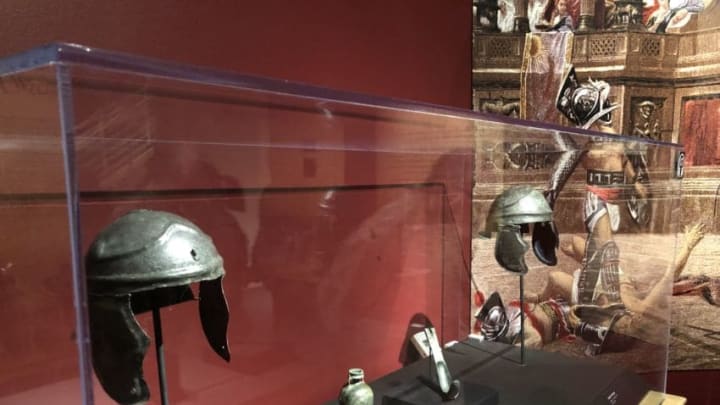(Header photograph: Pompeii: The Exhibition, Soldier and Gladiator helmets, 1st Century AD)
Fact is often stranger and more fascinating than fiction. This old adage couldn’t be more true than when it comes to the famously tragic fate of the ancient Roman cities of Pompeii and Herculaneum. Game of Thrones fans who were sorely disappointed with the 2014 movie Pompeii (starring Kit Harington) are well-served to take a little time to explore the true story, which is infinitely more compelling.
RELATED PRODUCT

Philadelphia Phillies Game Of Thrones White Walker Bobblehead
Buy Now!
Buy Now!
Pompeii: The Exhibition is currently showing at the Ronald Reagan Presidential Library and Museum in Simi Valley, California. The exhibit consists of over 150 artifacts from the famous Naples National Archaeological Museum in Italy. All of these objects were near-perfectly preserved under 15 feet of volcanic ash and debris for more than 2,000 years.

With the artifacts sumptuously displayed, the exhibit encourages 360 degree viewing and reflection. Visitors move through a series of spaces designed to immerse them in the daily life of the busy Roman city, from the stalls of street vendors to the solitude of the garden. You can almost smell the garum, a salty fermented fish sauce popular as a flavoring for the often bland Roman foods.
The artifacts include amphorae, wall frescoes, bronze and marble sculptures, gladiator and soldier helmets, ceramics, furniture, jewelry, blue glass perfume decanters and much more. The exhibit also features the 4D Eruption Theater, where the visitor can experience the CGI destruction of Pompeii by Mount Vesuvius’s eruption and resulting volcanic pyroclastic flow, complete with sensurround-type sound and fog machines. Here’s the animation, but it’s better with the effects.
Once you’ve departed the galleries packed with elements of vibrant Roman life, of faces looking back from you in bright colors from the wall frescoes and mosaics, you arrive in the gallery of the dead. Here you walk past the twisted, contorted forms of huddled Roman men, women, children and domestic animals as they fell in agony, asphyxiated by searing heat and poisonous gases.
Most of the bodies eventually decomposed in their compacted ash tombs, leaving voids behind. Upon discovering the voids about 250 years ago, archaeologists filled the holes with plaster and captured the ghastly body molds of the long-dead Romans struggling in their last moments of life.

It’s a somber, terrible, awe-inspiring scene to witness, the price of history captured in time.
That time was August 24, 79 A.D. Two busy Roman towns sat in the shadow of Mount Vesuvius: the busy commercial port of Pompeii, an important Roman military and trading center, and the smaller Herculaneum, a resort town for the wealthy. Mount Vesuvius erupted that morning, expelling molten rock and pumice at a rate of 1.5 million tons per second.
Volcanic ash and rocks filled the sky and blocked out the sun, locking the Roman cities in an unnatural night. Twenty-four hours later, Pompeii and Herculaneum were utterly destroyed and every living creature within them dead. It is calculated that approximately 16,000 Romans died, most of them in their homes or on the streets they used every day.

Time passed, the Roman Empire fell and faded into history, and the existence of Pompeii and Herculaneum was forgotten. The ruins of Herculaneum were rediscovered in 1738 by builders digging the foundation for the summer palace for the King of Naples, Charles the Bourbon. The remains of Pompeii were first uncovered in 1748.
In another Game of Thrones angle, one can see a lot of parallels between what happened to Pompeii and Herculaneum and the mysterious fall of Valyria. Like Rome, Valyria was an all-conquering, militarily powerful empire. And like the ill-fated Roman cities, its capital was obliterated by the “Doom,” when a string of volcanoes erupted and annihilated the city in a cataclysm of fire and ash.
Pompeii: The Exhibition closes at the Ronald Reagan Presidential Library and Museum on April 21, 2019.
To stay up to date on everything Game of Thrones, follow our all-encompassing Facebook page and sign up for our exclusive newsletter.
Check out Game of Thrones swag at Entertainment Earth.
Watch Game of Thrones for FREE with a no-risk, 7-day free trial of Amazon Channels
